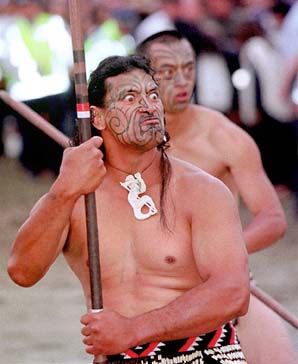|
|
Canku Ota |
|
|
(Many Paths) |
||
|
An Online Newsletter Celebrating Native America |
||
|
November 16, 2002 - Issue 74 |
||
|
|
||
|
Maori Language Enjoys Resurgence |
||
|
by © 2002 ABC
|
||
|
credits:This is
a transcript of The World Today broadcast at 1200 AEST on local radio
|
 ELEANOR
HALL: Two decades ago it was written off as a dying language. ELEANOR
HALL: Two decades ago it was written off as a dying language.
But now Maori is not only spoken fluently by at least a quarter of New Zealand's indigenous population, but many non-Maori New Zealanders can also hold a basic conversation in the country's native tongue. Indeed, a report into the language by the New Zealand Government shows Maori is spoken by more than 130,000 New Zealanders. This report from our New Zealand correspondent Gillian Bradford. GILLIAN BRADFORD: In the 1960s and '70s many New Zealanders assumed the Maori language was in terminal decline. Maori who were fluent were getting old and children weren't taught Maori at school or encouraged to speak it at home. But fortunately for New Zealand, language became the central theme of persistent Maori protests and by the early 1980s, the Government responded by acknowledging its duty to ensure the survival of the language. The latest study by the Ministry of Maori Affairs shows the Maori language is no longer in decline, that a quarter of Maori now speak the language. Though pleased it's in no immediate danger of dying, the chief executive of the Maori Language Commission, Haami Piripi, says it's too early to assume the language has been saved. HAAMI PIRIPI: Some work done by the United Nationals last year showed that in order for a language to adequately sustain itself, it needs something like 100,000 native fluent speakers and I think we've got some way to go to develop a level of proficiency required amongst the population. I think we had a big swing towards language acquisition, but we've got a long way to go in terms of language proficiency and developing the language as an ordinary living language of the Maori people. GILLIAN BRADFORD: So although 130,000, some 25 per cent of the Maori population and another 30,000 non-Maori say they can speak Maori, it's not at a proficiency that is enough to save the language? HAAMI PIRIPI: That's right. We need to deepen and bridge, extend the bridge of the language to enable it to be used on an everyday basis by a large number of people. GILLIAN BRADFORD: Do you though remember yourself, even some 20 years ago, fearing for the survival of the language? HAAMI PIRIPI: Oh absolutely. I think the survival of the language can be clearly attributed to the development of the early childhood program, the (inaudible), which was a Maori language program developed amongst Maori communities. We're, in this report we're now seeing the results of that work beginning to show and a new generation of language speakers emerging. But we, not enough to cover the amount of language speakers we're losing through old age and ill health. GILLIAN BRADFORD: So what do you do then now? It's being spoken in schools very broadly. There's about to be Maori television. What else needs to be done to ensure the language doesn't die out? HAAMI PIRIPI: As a matter of fact we've just come back from Canberra working with the Australian National University there in Canberra, the Pacific languages department, and we're working with, on a program to try and develop a scholarly pursuit of the language using modern technology and things that young people are getting into. Computers, software programs and using all this high speed stuff to teach people language and enable them to use it GILLIAN BRADFORD: What is your aim then through those sorts of tools? What percentage of Maori will be speaking the language? What's the goal? HAAMI PIRIPI: Well our vision for our commission is that Maori will once again be the first language of the Maori people. And that's a pretty lofty vision but we think it's certainly achievable. And it's just a matter of making the language live again. And our big focus for the next three years is establishing the language in the home as a normal everyday language between parents and children, within their homes. ELEANOR HALL: The chief executive of the Maori Language Commission, Haami Piripi, speaking to our New Zealand Correspondent Gillian Bradford. |
|
|
||
|
|
||
| Canku Ota is a free Newsletter celebrating Native America, its traditions and accomplishments . We do not provide subscriber or visitor names to anyone. Some articles presented in Canku Ota may contain copyright material. We have received appropriate permissions for republishing any articles. Material appearing here is distributed without profit or monetary gain to those who have expressed an interest. This is in accordance with Title 17 U.S.C. section 107. | ||
|
Canku Ota is a copyright © 2000, 2001, 2002 of Vicki Lockard and Paul Barry. |
||
 |
 |
|
|
The "Canku Ota - A Newsletter Celebrating Native America" web site and its design is the |
||
|
Copyright © 1999, 2000, 2001, 2002 of Paul C. Barry. |
||
|
All Rights Reserved. |
||